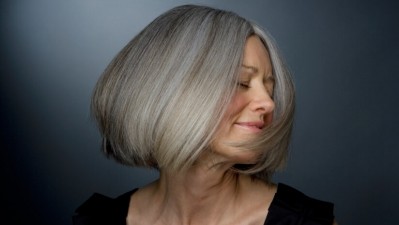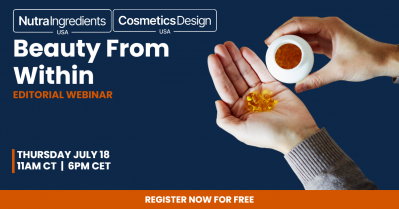Beauty meets wellness: Emerging trends in nutricosmetics

Sherry Frey, vice president of wellness at NielsenIQ, kicked off the webinar with an overview of the evolving consumer landscape, where beauty and wellness are merging and consumers are seeking more holistic ingestible beauty solutions with ingredients like carotenoids, collagen and bioactives. Frey highlighted the challenges and opportunities this presents for brands as they navigate the blurring lines between personal care, supplementation and functional beverages.
“This blurring is pretty fantastic,” she said. “It means there's really great opportunities as brands are thinking about moving across lines and across segments. It also will mean that consumers are looking more for solutions, and it doesn't always mean that they're going to be looking for it in a specific form. And that gives us some opportunities but also some challenges in terms of where consumers are looking for specific solutions to need states.”
While beauty supplements make up a small portion of the overall dietary supplement market, certain ingredients like biotin, collagen and hyaluronic acid have seen strong growth. Specific areas of concern for consumers include age spots, skin lifting and tone correction. Overall, Frey observed that the beauty supplement industry is evolving to meet changing consumer needs and preferences.
Menopause and skin
Another consumer concern that has garnered increasingly more attention is menopause, a category that comes with its own unique set of challenges—including skin health.
“We've got millennials who are in perimenopause today, and for the most part, when you think about menopause, we can all kind of name weight gain or hot flashes or brain fog,” Frey said.
“But really, there's a plethora of ailments and challenges that women that are going through menopause are struggling with, and one of those is really very much around their skin health. This is an opportunity to think about where the future need states will be—things like skin health, managing hormones, really meeting these need states from these consumers in a very nuanced way. We think this is an interesting area of opportunity.”
Microbiome and skin
Another area of opportunity mentioned is the gut-skin axis. As consumers become more educated on the gut microbiome’s influence on everything from vaginal health to mental health, the skin microbiome is gaining attention for its role in skin health. And as CosmeticsDesign-USA’s Editor Cassandra Stern noted, the microbiome has established itself as a health and wellness staple that’s here to stay.
"When I go to shows like In-Cosmetics or cosmoprof or other types of industry shows, there is always a very strong microbiome presence," she said. "I think we are continuing to see really intriguing innovations in the microbiome space.
"Last year I spoke with a cosmetic chemist who was doing work in virology and its intersection with the microbiome, which was also fascinating. They were working on acne treatment that would target the acne-causing bacteria, while still maintaining the healthy flora of the skin's microbiome."
Menopause and the microbiome
While many may not link menopause to beauty-from-within or gut health, Paula Simpson, innovation, product development and branding consultant at Nutribloom Consulting, pointed out that it is all intertwined.
“Hair thinning, skin epidermal thinning, hypersensitivity on the skin, changes in GI health and ‘gut aging’ if you will, and the influence of GI aging on the health and appearance of our skin are all areas that are interesting from a microbiome perspective,” she said.
Frey agreed, noting that she has noticed an increased awareness and understanding from consumers in terms of how the microbiome affects all aspects of health.
“It's like this holistic view that we are really seeing consumers expanding how they're defining wellness and saying yes, my digestive health is a big part of it, but also it affects so many other elements of the body. And they're making those linkages more than we've ever seen and across all generations,” Frey said.
Personalization and the microbiome
Stern shared that from a media perspective, the microbiome is certainly something she’s keeping tabs on.
"Most recently I did an article with a company that is working on DNA phenotyping for the skin microbiome which was fascinating, and that was definitely something they felt was trending, which is innovations in DNA," she said.
“Companies are starting to be able to actually work with an individual consumer and look at their particular DNA, their particular makeup and be able to target exactly what their needs are. So for example, if you have vitamin deficiencies that are impacting the skin's dullness…they would be able to take a look and be able to see that you're deficient in those types of vitamins and then be able to develop a particular support supplement that would target those issues for you."
Anti-aging vs. well-aging
Simpson highlighted how longevity is a big driver in the market today as consumers eschew the idea of anti-aging in favor of well-aging.
“How do we feel? Are we getting enough sleep? And sleep is recovery. So when we're recovering, we're restoring, right? And we're renewing the body. So if we're not getting enough sleep, often our skin will look tired and it shows on the outside. So that driver for high quality sleep, less stress, the active lifestyle, vitality – those are all coming in as more primary claims for nutricosmetics versus before it was very skin-focused," she said.
"And this all has an accumulative effect on how we look aesthetically throughout the lifecycle, so I really think the beauty-from-within category is at such a unique and exciting time. It leaves a lot of opportunity for different brands and companies out there to target their demographic and build a product that the consumer is really going to love and be loyal to."
















